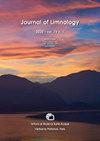Assessing the potential environmental factors affecting cladoceran assemblage composition in arsenic-contaminated lakes near abandoned silver mines
IF 1.1
4区 环境科学与生态学
Q4 LIMNOLOGY
引用次数: 0
Abstract
Silver mining in Cobalt (Ontario, Canada) has a long history that has left a complex environmental legacy where many lakes are contaminated with arsenic-rich mine tailings. In this exploratory survey, we examined subfossil Cladocera remains in the surface sediments of 22 lakes in the abandoned mining region to assess which environmental variables may be influencing the recent assemblage structure. Further, using a “top-bottom” paleolimnological approach, we compared the recent (top) and older (bottom) assemblages from a subset of 16 lakes to determine how cladoceran composition has changed in these lakes. Our regional survey suggests that the cladoceran assemblages in the Cobalt area are primarily structured by differences in lake depth, while site-specific limnological characteristics, including those related to past mining activities, may have limited roles in shaping the recent cladoceran compositions. The top-bottom paleolimnological analysis suggests that the cladoceran assemblages have changed in most lakes around Cobalt, however the magnitude and nature of changes varied across the study sites. As with most regional biological surveys, the responses to historical mining activities were not uniform across all sites, which further emphasizes the importance of considering site-specific limnological characteristics and multiple environmental stressors when assessing the impacts of mining pollution. Corresponding author: branaavan.sivarajah@gmail.com Edited by: Diego Fontaneto, CNR-IRSA Water Research Institute, Verbania, Italy.评估废弃银矿附近砷污染湖泊中影响枝角类群落组成的潜在环境因素
Cobalt(加拿大安大略省)的银矿开采历史悠久,留下了复杂的环境遗产,许多湖泊被富含砷的尾矿污染。在这次探索性调查中,我们检查了废弃矿区22个湖泊表层沉积物中的分支角类化石遗迹,以评估哪些环境变量可能影响最近的组合结构。此外,使用“顶部-底部”古湖沼学方法,我们比较了16个湖泊子集的最新(顶部)和较老(底部)组合,以确定这些湖泊中枝角类组成的变化。我们的区域调查表明,Cobalt地区的枝角类组合主要是由湖泊深度的差异构成的,而特定地点的湖沼特征,包括与过去采矿活动有关的特征,在形成最近的支角类组成方面可能作用有限。自上而下的古湖沼学分析表明,在钴周围的大多数湖泊中,支角类组合都发生了变化,但不同研究地点的变化幅度和性质各不相同。与大多数区域生物调查一样,并非所有地点对历史采矿活动的反应都是一致的,这进一步强调了在评估采矿污染的影响时考虑特定地点的湖沼特征和多种环境压力源的重要性。通讯作者:branaavan.sivarajah@gmail.com编辑:Diego Fontaneto,CNR-IRSA水研究所,意大利韦尔巴尼亚。
本文章由计算机程序翻译,如有差异,请以英文原文为准。
求助全文
约1分钟内获得全文
求助全文
来源期刊

Journal of Limnology
地学-湖沼学
CiteScore
2.70
自引率
6.20%
发文量
12
审稿时长
3 months
期刊介绍:
The Journal of Limnology publishes peer-reviewed original papers, review papers and notes about all aspects of limnology. The scope of the Journal of Limnology comprises the ecology, biology, microbiology, physics, and chemistry of freshwaters, including the impact of human activities, management and conservation. Coverage includes molecular-, organism-, community-, and ecosystem-level studies on both applied and theoretical issues. Proceedings of workshops, specialized symposia, conferences, may also be accepted for publication.
 求助内容:
求助内容: 应助结果提醒方式:
应助结果提醒方式:


